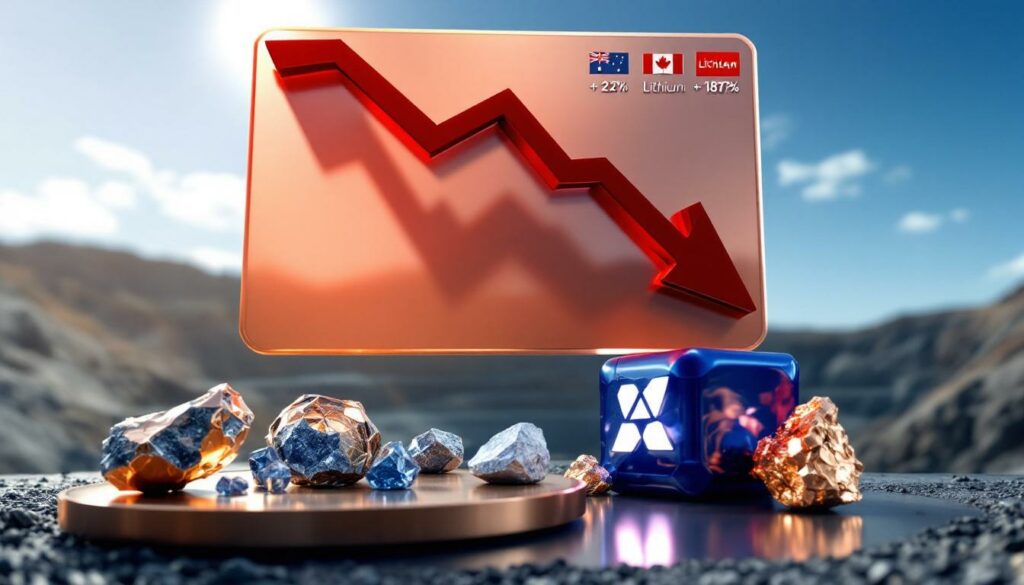What Caused Rio Tinto's 22% Earnings Drop in H1 2025?
Rio Tinto, one of the world's largest mining companies, reported a significant decline in financial performance during the first half of 2025. The company's net earnings fell by 22%, dropping to $4.53 billion from $5.81 billion in the same period last year. This substantial decrease has prompted investors and industry analysts to examine the underlying factors affecting the mining giant's operations and profitability.
The earnings slump comes amid challenging market conditions, with several commodities experiencing price pressure and global trade tensions impacting profit margins.
Key Financial Metrics Showing Decline
| Financial Indicator | H1 2025 | H1 2024 | Change |
|---|---|---|---|
| Net Earnings | $4.53bn | $5.81bn | -22% |
| Underlying EBITDA | $11.55bn | $12.09bn | -4.5% |
| Net Cash from Operations | $6.92bn | $7.05bn | -1.9% |
| Free Cash Flow | $1.96bn | $2.84bn | -31% |
| Net Debt | $14.6bn | $5.08bn | +187% |
The financial metrics reveal concerning trends beyond the headline earnings figure. Perhaps most alarming is the 187% increase in net debt, which has nearly tripled from $5.08 billion to $14.6 billion year-over-year. This significant debt expansion has pushed Rio Tinto's debt-to-EBITDA ratio to approximately 1.27x, up from roughly 0.8x in the previous period.
Primary Factors Behind the Financial Decline
The company's financial performance was impacted by several key factors:
- Lower commodity prices across various segments, particularly affecting iron ore, copper, and aluminum revenues
- Increased capital expenditure rising to $4.73 billion from $4.02 billion, representing an 18% year-over-year increase
- Tariff costs reaching $321 million, creating direct pressure on profit margins
- US duties on Canadian aluminum increasing from 25% to 50%, significantly impacting the company's North American operations
These factors collectively contributed to the significant reduction in earnings and the substantial increase in net debt. The impact of tariffs alone cost the company $321 million during the reporting period, representing approximately 7% of the company's net earnings.
Commodity Price Pressures
The decline in commodity prices represents one of the most significant headwinds facing Rio Tinto. Iron ore price trends have experienced particular volatility, trading around $100 per ton compared to peaks above $150 in previous periods. This price deterioration directly impacts Rio Tinto's Pilbara operations, which form the backbone of the company's revenue generation.
Aluminum prices have also faced downward pressure, a situation exacerbated by the increased US tariffs on Canadian aluminum. This double impact of lower market prices and higher trade barriers has created a particularly challenging environment for Rio Tinto's aluminum division.
Operational Challenges
Beyond market-driven factors, Rio Tinto also faced operational challenges during H1 2025:
- Weather disruptions in the Pilbara region, with cyclone activity impacting iron ore shipments
- Increased production costs across several key operations
- Rising energy expenses affecting overall operational margins
- Higher exploration expenditures approaching the $1 billion mark
The combination of lower prices and operational hurdles has created significant pressure on the company's profit margins and cash flow generation.
How Is Rio Tinto Responding to Financial Challenges?
Despite the financial downturn, Rio Tinto is maintaining a strategic approach to navigate these challenges while positioning itself for future growth. CEO Jakob Stausholm has emphasized the company's commitment to long-term strategic objectives despite the near-term earnings pressure.
"We remain on track to deliver strong mid-term production growth, with solid foundations in place and a diverse pipeline of options for the future," Stausholm stated in the company's earnings release.
Maintained Production Forecasts
The company has kept its production forecasts consistent across various commodities for 2025, demonstrating confidence in its operational capabilities:
- Pilbara iron ore shipments: Expected at the lower end of guidance due to cyclone impacts, but the company maintains its 320-335 million ton annual target
- Bauxite production: Projected at the higher end of the range, driven by strong performance at the Amrun project in Australia
- Copper production: Anticipated at the higher end due to strong output from Oyu Tolgoi in Mongolia and Escondida in Chile
- Titanium dioxide slag: Forecast at the lower end due to market demand constraints and inventory management strategies
This balanced approach across commodities suggests Rio Tinto is adjusting its operational focus to prioritize higher-performing assets while maintaining disciplined production at operations facing greater market challenges.
Strategic Investment Focus
Rio Tinto is strategically prioritizing investments in high-demand minerals:
- Copper and lithium receiving increased focus amid rising global demand for energy transition materials
- Capital investment guidance maintained at $11 billion for 2025, demonstrating commitment to growth despite earnings pressure
- Arcadium lithium project continuing as a key strategic investment aligned with battery metal demand projections
- Selective project advancement based on rigorous return-on-investment criteria
The company's strategic pivot toward battery metals and copper price insights aligns with long-term demand forecasts from organizations like the International Energy Agency, which projects lithium demand to increase by 40-fold by 2040 in scenarios compatible with climate goals.
Financial Management Strategies
To maintain financial stability while pursuing growth opportunities, Rio Tinto is implementing several financial management strategies:
- Maintaining dividend policy with a 50% interim payout resulting in a $2.4 billion ordinary dividend
- Disciplined investment approach in growth projects while maintaining balance sheet strength
- Tax rate management with expectations of a temporary increase to 33% in 2025, returning to 30% in 2026
- Controlled exploration expenses projected to be slightly below the $1 billion guidance for 2025
"Our strong cash flow enables us to maintain our practice of a 50% interim payout," noted Stausholm, highlighting the company's commitment to shareholder returns despite the earnings decline.
The decision to maintain the dividend despite the 31% drop in free cash flow (now $1.96 billion versus $2.84 billion in H1 2024) signals confidence in the company's underlying financial strength but raises questions about dividend sustainability if current trends continue.
What Are the Long-Term Implications for Rio Tinto?
The current financial challenges present both risks and opportunities for Rio Tinto's long-term position in the global mining industry. The company's strategic decisions during this transitional period will likely determine its competitive positioning for years to come.
Growth Opportunities Amid Challenges
Despite current financial pressures, Rio Tinto is positioning itself to capitalize on emerging market trends:
- Mid-term production growth remains on track according to company projections, with particular emphasis on copper expansion
- Diverse project pipeline provides multiple options for future development across different commodity classes
- Growing demand for key products expected to drive future revenue growth, particularly in energy transition minerals
- Best-in-class project execution capabilities provide competitive advantage in delivering complex mining projects on budget
The company's strategic focus on copper and lithium reflects a long-term bet on energy transition materials. Copper demand is projected to double by 2035 according to industry analyses, driven by electrification, renewable energy infrastructure, and electric vehicle production. Similarly, lithium carbonate demand is expected to triple by 2030 from 2022 levels, creating significant market opportunities.
Market Position and Competitive Landscape
Rio Tinto's strategic decisions during this challenging period will likely influence its competitive position:
- Focus on copper and lithium aligns with global energy transition trends and positions the company favorably against peers still heavily dependent on traditional commodities
- Maintained production forecasts demonstrate operational resilience compared to competitors who have been forced to reduce output targets
- Continued dividend payments signal confidence to investors despite earnings decline, potentially attracting yield-focused investors
- Strategic capital allocation prioritizes high-growth potential areas while managing overall investment levels
The company's debt increase does create potential vulnerability compared to competitors with stronger balance sheets. BHP, for example, maintains a lower debt-to-EBITDA ratio of approximately 0.5x compared to Rio Tinto's 1.27x, giving BHP potentially greater financial flexibility.
Technology and Innovation Focus
Rio Tinto has emphasized technological innovation as a key differentiator in its long-term strategy:
- Automation in mining across operations to improve efficiency and reduce costs
- Process innovations to improve metal recovery rates and reduce environmental footprint
- Carbon reduction technologies to address increasing investor focus on ESG performance
- Digital transformation of mining operations to improve predictive maintenance and operational efficiency
These innovation initiatives may help offset some of the margin pressure created by lower commodity prices and higher operational costs.
How Do External Factors Impact Rio Tinto's Performance?
External market conditions and geopolitical factors are playing a significant role in shaping Rio Tinto's financial outcomes, with trade policies and commodity price volatility creating particular challenges.
Trade Policies and Tariffs
International trade tensions are directly impacting Rio Tinto's bottom line:
- $321 million in tariff costs affecting profitability during H1 2025
- Increased US duties on Canadian aluminum from 25% to 50% creating additional pressure on North American operations
- Global trade policy shifts influencing market access and pricing for key commodities
- Regional supply chain disruptions affecting logistical efficiency and transportation costs
The aluminum tariff increase is particularly significant for Rio Tinto, which operates substantial aluminum assets in Canada through its Rio Tinto Alcan division. The tariff increase directly impacts profit margins on aluminum exports to the crucial US market.
Commodity Price Volatility
Fluctuations in commodity prices remain a key determinant of financial performance:
- Lower commodity prices cited as a primary factor in earnings decline across multiple segments
- Market demand variations affecting different segments differently, with industrial metals facing greater pressure than battery materials
- Price sensitivity across the company's diverse portfolio of products creating uneven performance
- Forward price curves suggesting continued volatility through the remainder of 2025
"The commodity price environment remains challenging across several of our key markets, creating headwinds that we're addressing through operational excellence and strategic positioning," a company spokesperson noted in industry discussions.
Iron ore price fluctuations have been particularly impactful, with prices experiencing 15-20% volatility within six-month periods. Given that iron ore represents approximately 60% of Rio Tinto's revenue, these price movements have outsized effects on overall financial performance.
Regulatory and ESG Pressures
Beyond trade and price factors, Rio Tinto also faces increasing regulatory scrutiny and ESG expectations:
- Carbon pricing mechanisms in various jurisdictions affecting operational costs
- Water management regulations impacting project development timelines and costs
- Community relations requirements creating additional project complexity and potential delays
- Investor ESG expectations influencing capital allocation decisions and corporate strategy
These regulatory factors create additional complexity in project planning and execution, potentially affecting the company's ability to deliver on growth targets.
What Financial Metrics Should Investors Monitor?
For stakeholders evaluating Rio Tinto's financial health and future prospects, several key metrics warrant close attention beyond the headline earnings figures.
Critical Performance Indicators
| Indicator | Significance | Current Status |
|---|---|---|
| Free Cash Flow | Measures ability to generate cash after capital expenditures | Down 31% to $1.96bn |
| Net Debt | Indicates financial leverage and potential risk | Increased to $14.6bn |
| Capital Expenditure | Shows investment in future growth | Up to $4.73bn from $4.02bn |
| Dividend Payout | Reflects shareholder return policy | Maintained at 50% interim payout |
| Production Forecasts | Indicates operational expectations | Maintained across commodities |
The most concerning metric for investors should be the free cash flow decline combined with increasing debt levels. The current free cash flow of $1.96 billion is insufficient to cover the $2.4 billion dividend payment, suggesting that debt financing is supporting shareholder returns in the short term.
Balance Sheet Considerations
The significant increase in net debt requires careful monitoring:
- Debt-to-EBITDA ratio trending upward to approximately 1.27x from 0.8x
- Interest coverage capacity with declining earnings raising questions about future debt servicing costs
- Liquidity position amid increased capital expenditure and maintained dividend payments
- Debt servicing capabilities in a challenging market environment with lower commodity prices
While Rio Tinto's debt levels remain manageable by industry standards, the rapid increase in leverage raises questions about future financial flexibility if market conditions remain challenging.
Operational Efficiency Metrics
Beyond financial statements, investors should monitor:
- Unit production costs for key commodities like iron ore, copper, and aluminum
- Project delivery timelines for major capital investments, particularly in copper and lithium
- Resource replacement rates to ensure long-term production sustainability
- Energy efficiency metrics as indicators of cost control capabilities
Operational efficiency improvements could help offset some of the margin pressure created by lower commodity prices and higher input costs.
Return on Invested Capital
The company's return on invested capital (ROIC) has declined with the earnings drop and increased capital base. Investors should monitor whether:
- New projects deliver projected returns on investment
- Capital allocation discipline is maintained despite growth ambitions
- Divestment of underperforming assets continues to optimize the portfolio
- Project hurdle rates are adjusted appropriately for the higher interest rate environment
FAQ: Rio Tinto's H1 2025 Financial Performance
How much did Rio Tinto's net earnings decline in H1 2025?
Rio Tinto's net earnings declined by 22%, falling to $4.53 billion from $5.81 billion in H1 2024.
What happened to Rio Tinto's free cash flow?
Free cash flow decreased by 31% to $1.96 billion, primarily due to increased capital expenditure and lower operational cash generation.
Is Rio Tinto maintaining its dividend despite the earnings decline?
Yes, Rio Tinto is maintaining its practice of a 50% interim payout, resulting in a $2.4 billion ordinary dividend, which actually exceeds the company's free cash flow for the period.
What are the main factors behind Rio Tinto's earnings decline?
The main factors include lower commodity prices across key segments, higher capital spending, and increased tariff costs, particularly from US duties on Canadian aluminum which rose from 25% to 50%.
How has Rio Tinto's debt position changed?
Net debt has nearly tripled to $14.6 billion from $5.08 billion in the previous year, pushing the debt-to-EBITDA ratio to approximately 1.27x.
What is Rio Tinto's strategic focus for future growth?
The company is prioritizing copper and lithium amid rising demand for energy transition materials, while maintaining its capital investment guidance at $11 billion for 2025.
How are Rio Tinto's production forecasts affected by recent challenges?
Despite the financial headwinds, Rio Tinto has maintained its production guidance across key commodities, though Pilbara iron ore shipments are expected at the lower end of the forecast range due to weather disruptions.
What commodity segments are performing relatively better?
Copper production is expected at the higher end of guidance due to strong output from Oyu Tolgoi and Escondida, while bauxite production is also projected at the higher end of the range, driven by strong performance at the Amrun project.
Investing Implications: What This Means for Shareholders
The financial performance decline creates both challenges and opportunities for Rio Tinto shareholders. The maintained dividend policy offers near-term yield support, but the sustainability of these payments bears watching given that the current dividend exceeds free cash flow.
For long-term investors, Rio Tinto's strategic pivot toward energy transition materials like copper and lithium may position the company favorably despite near-term headwinds. The company's project pipeline and operational expertise provide foundation for future growth once commodity prices stabilize or improve.
However, the substantial increase in net debt and declining free cash flow suggest financial discipline will be crucial in coming quarters. Investors should monitor quarterly production reports and commodity price trends closely to gauge whether the current challenges represent a temporary setback or a more sustained shift in operating conditions.
Furthermore, the ongoing mining industry evolution will likely influence Rio Tinto's strategic decisions as the company navigates the current challenging environment.
Disclaimer: This analysis contains forward-looking statements and projections based on current information. Commodity markets are inherently volatile
Looking to Get Ahead on the Next Major ASX Discovery?
Discovery Alert's proprietary Discovery IQ model delivers instant notifications when significant mineral discoveries hit the ASX, giving you a crucial market advantage before the crowd. Explore why major mineral discoveries can lead to substantial returns by visiting the dedicated discoveries page and start your 30-day free trial today.




